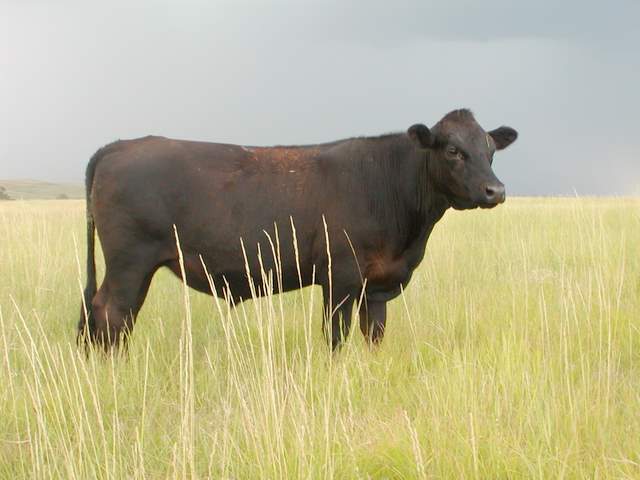
For the longest time, I did not know or believe that “composition has the greatest impact on functional reproductivity”. Now that I have met Leonhardt and studied Bonsma, I understand that the most valuable thing I can do as a breeder is to select and stabilize a good maternal type. Realizing that “production values are self-governed by the environment”, I have stopped selecting for more growth and instead I let those values fall where they may. Our EPD’s are stabilizing somewhat below breed average and I worry at times that my customers will lose too much performance. People often ask me, “If you calved in March, what would your weaning weights be?” and the truth is I don’t know. So I have watched the steer pictured above with interest. He was born March 13, 2008 with an 84 pound birth weight. His EPD’s are +2.1 birth, +20 weaning, +34 yearling, and +16 milk. His $#EN is +20.94 and $WN is+19.59. He is slightly inbred with a coefficient of 8.66%. His ancestry is full of fertile, feminine cows that lasted and worked. He was wintered through some bitter cold and nasty spring blizzards with nothing but winter range and a protein tub. With all this in mind, I was pleased when we weighed him off grass, on August 5, 2009, and he weighed 946#. What’s more, I think he can go on to the feedlot and continue to gain and carry enough weight to be profitable for the next guy. I expect he will grid quite well because this kind usually does. All this to say that if you want a low-cost, straight-bred system, my experience is that performance will be adequate and certainly the inputs will be lower with this type. Maternal values can also be consistently excellent if selection is for proper conformation and production values are in line with the environment.
From a terminal perspective he’s easy to criticize. We could want him to be more muscular, or higher marbling, more volume/appetite, or larger framed. Perhaps we might like him to be smaller framed and earlier maturing if we wanted to grass finish him. Clearly there are any number of genetic changes we could make to have the resulting steer top whatever terminal market we are aiming for. However any one of these changes would likely have disastrous effects on the maternal conformation represented by the dams in his pedigree.
The only way I know to have “more” of whatever terminal characteristics are desired is to break the genetics up into maternal and terminal parts.
Therefore, there are two excellent genetic systems available, both of which are being completley ignored by the entire industry.
The first is a straight-bred maternal system. Very profitable because it is simple, low-input, consistent, and produces average steers and excess high quality breeding females.
The second would utilize just enough maternal bulls to provide replacement heifers. With proper maternal selection replacement females rates can be very low. The rest of the cow herd can then be mated to produce for whatever market is desired. This is the only way I know that you can have your cake and eat it too.